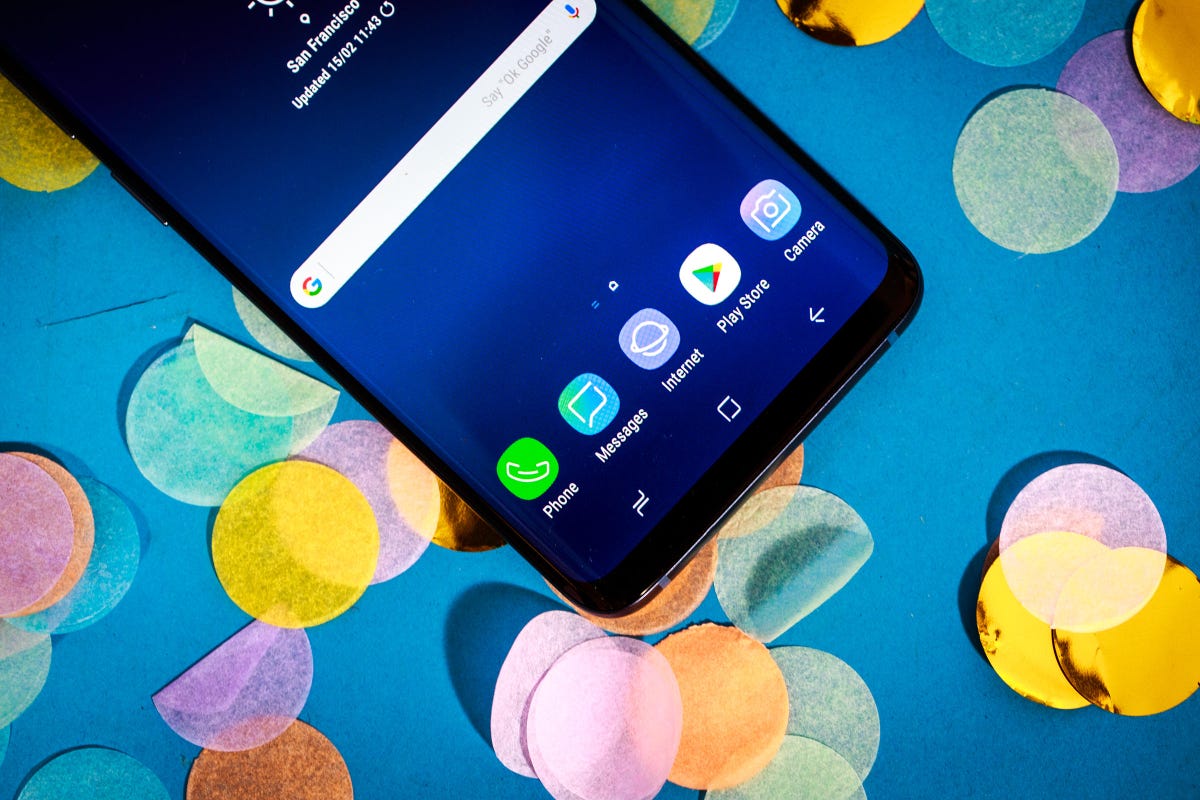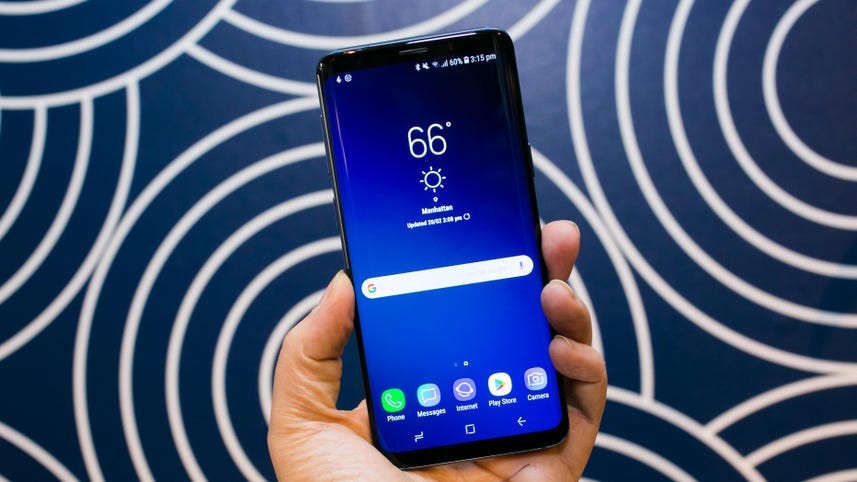
Drag the shortcuts menu
The Galaxy S9 is Samsung's first phone to let you drag and drop the Edge menu, a shortcuts bar for apps and people, anywhere you want on the left or right edges. In previous phones, you had to select its position in the settings.
Swipe here for notifications
The fingerprint sensor gets gesture support. In the settings, you can turn on the option to swipe down to open notifications, or swipe up to open Samsung Pay. Naturally, gestures stop working when you're actively scanning your fingertip.
Change the clock style
Open Clock Style in Settings > Lock Screen to change the Galaxy S9's default clock colors and style.
Change the clock style
You can pick different colors and styles for the Always On display and Lock Screen.
Swipe down to respond to notifications
When you're in an app -- say reading an article or navigating on maps -- you'll be able to reply to texts without leaving the screen.
Swipe down to respond to notifications
Just swipe down on an incoming message to expand the window.
Swipe down to respond to notifications
After you respond, you'll have to close the window.
Swipe down to respond to notifications
The edge of the phone lights up to subtly alert you to an incoming message, which is really cool.
Home screen supports landscape orientation
You're watching a video or playing a game, and you need to exit out to the home screen. Now when you do, you have the option of seeing your home page and app icons in horizontal mode, too.
To turn it on: Settings > Display > Home screen > Portrait mode only > Toggle off.
Home screen supports landscape orientation
The setting applies to your app drawer, too.
Selfie focus
This feature is one that's flown under the radar, but it's going to be used way more often than gimmicks like AR Emoji. The Galaxy S9 uses software to blur the background on your self portraits, so your face really stands out. You can also adjust skin tone and color.
To use it: Open the selfie camera > select Selfie Focus.
Regular selfie
Here's the regular selfie mode.
Change screen resolution
The S9 and S9 Plus' max screen resolution is 2,960x1,440 pixels (also known as WQHD+), but did you know that the phone defaults to 2,220x1,080 pixels (FHD+)? The more conservative setting preserves battery life, but for maximum detail, you can adjust the setting up or even down to 1,480x720 pixels (HD+).
Go into Settings > Display > Screen resolution.
Dual messenger
If you have two accounts for a social messenger app, you'll now have the choice to download a second instance of the app so you can easily pop from one to the other without swapping your profile within an app.
Go to Settings > Advanced features > Dual Messenger.
Dual messenger
It works with Facebook, Facebook Messenger, WhatsApp, Snapchat, Skype, Viber and Telegram.
Touch sensitivity
If you find yourself mashing the screen harder through your screen protector, you can increase the screen sensitivity.
Go to Settings > Advanced features > Touch Sensitivity.
Check your blood pressure
Galaxy phones have had a heart rate monitor since the Galaxy S5. The S9 adds a blood pressure reading. They call it "heart load factor." This is a wellness feature to provide an idea of your blood pressure, but Samsung isn't making any medical claims. You'll still need to consult your doctor for medical advice, or for monitoring a condition.
In addition, Samsung has partnered with UCSF to share your blood pressure information, and can monitor your stress levels to give you guidance for lowering your blood pressure.
Go to Samsung app folder > Samsung Health > tap HLF.
Switch Dolby Atmos off and on
The Dolby Atmos codec supplies 360-degree sound. It's turned off by default, but you can toggle it on for richer audio.
Pull down quick notification settings to toggle it. This is a new feature and a new option for the S9.
Switch Dolby Atmos off and on
You can also touch and hold to switch among settings, like automated settings based on what you're watching, movie, music or voice -- like a speakerphone call.
Hidden features that carry over from the Galaxy S8 and Note 8
There are a load of tricks that aren't new for the S9 or S9 Plus, but if you're switching from a phone that predates the Galaxy S8 or a different brand, they could be new to you.
Dual capture
The Galaxy S9's second camera lens (the telephoto) makes portrait mode possible -- Samsung calls this Live Focus. What makes this different from other phones is that the S9s (and Note 8 before it) will save both the depth-of-field portrait and the full shot with the background unblurred. You'll have the option to use them both.
Go to Camera app > select Live Focus > Click the icon of two boxes
Dual capture
A closer look.
Make more room for apps
This is old hat for longtime Android users, but a good tip for first-timers. Shrinking the weather widget -- press and hold to select, then drag a corner -- will give you up to eight more app icons for the home screen. You can also delete the widget entirely.
Floating shutter button
Ever wished you didn't have to stretch your hand so far to reach the camera shutter button? You can actually drag it anywhere on the screen.
Portrait mode for foodies
You can softly blur the background of food shots from the inside out with a tool called radial blur. Food mode existed in previous Galaxy phones, but it's much easier to find on the S9. You can also adjust color tone to make shots look warmer or cooler.
Go to Camera > Food mode > Tap the icon that looks like the drop.
Swipe to toggle between camera modes
A quick way to flip between your current camera mode and the one before is to swipe up or down on the screen from within the camera app.
Swipe to toggle between camera modes
You don't just switch between front and rear cameras -- you can switch this way between modes in just the front or rear cameras.
Hide navigation
Double-tap the dot on the navigation bar to hide it. You can also go into Settings > Display > Navigation.
Change navigation bar color
For a subtly tinted navigation bar in light green, pink, purple and so on, head to the Settings. There's not really much of a difference and I prefer the Galaxy S8's much brighter color options.
Go to Settings > Display > Navigation.
Unlock secure folder with your fingerprint
If you tuck away notes and files into Secure Folder for safekeeping, you can now use any fingerprint, along with your iris, a PIN, pattern or password, to let you in. That means you can unlock your phone with your pointer finger and unlock Secure Folder with a different digit.
Samsung Pass
Samsung Pass can offer to remember and autofill certain fields in apps. It's similar to the autofill feature built into the Android 8.0 Oreo OS, and you can even switch to use Oreo's autofill instead.


